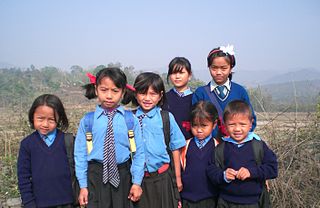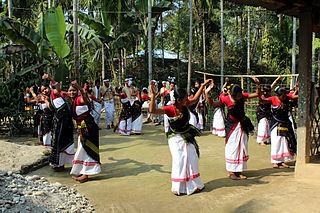
The Himalayas, or Himalaya is a mountain range in Asia, separating the plains of the Indian subcontinent from the Tibetan Plateau. The range has several peaks exceeding an elevation of 8,000 m (26,000 ft) including Mount Everest, the highest mountain on Earth. The mountain range runs for 2,400 km (1,500 mi) as an arc from west-northwest to east-southeast at the northern end of the Indian subcontinent.

The Brahmaputra is a trans-boundary river which flows through Southwestern China, Northeastern India, and Bangladesh. It is known as Brahmaputra or Luit in Assamese, Yarlung Tsangpo in Tibetan, the Siang/Dihang River in Arunachali, and Jamuna River in Bengali. By itself, it is the 9th largest river in the world by discharge, and the 15th longest.

The Salween is a Southeast Asian river, about 3,289 km (2,044 mi) long, flowing from the Tibetan Plateau south into the Andaman Sea. The Salween flows primarily within southwest China and eastern Myanmar (Burma), with a short section forming the border of Burma and Thailand. Throughout most of its course, it runs swiftly through rugged mountain canyons. Despite the river's great length, only the last 90 km (56 mi) are navigable, where it forms a modest estuary and delta at Mawlamyine. The river is known by various names along its course, including the Thanlwin in Burma and the Nu Jiang in China. The commonly used spelling "Salween" is an anglicisation of the Burmese name dating from 19th-century British maps.

The Ahom or Tai-Ahom is an ethnic group from the Indian states of Assam and Arunachal Pradesh. The members of this group are admixed descendants of the Tai people who reached the Brahmaputra valley of Assam in 1228 and the local indigenous people who joined them over the course of history. Sukaphaa, the leader of the Tai group and his 9,000 followers established the Ahom kingdom, which controlled much of the Brahmaputra Valley in modern Assam until 1826.

The Karbis or Mikir are a Tibeto-Burman ethnic group in Northeast India. They are mostly concentrated in the hill districts of Karbi Anglong and West Karbi Anglong of Assam.
The Tani language, often referred to as Tani languages, encompasses a group of closely related languages spoken by the Tani people in the northeastern region of India, primarily in the state of Arunachal Pradesh and Assam. These languages belong to the Sino-Tibetan family and include several major dialects such as Nyishi, Galo, Apatani, Adi, Tagin, and Mising.

The Chindwin River, also known as the Ningthi River, is a river flowing entirely in Myanmar, and the largest tributary of the country's main river, the Irrawaddy. Its official name is also spelled Chindwinn.

The Tripuri people (Kókborok: Tripuri dópha rok, are a Tibeto-Burman-speaking ethnic group of Bangladesh and Northeast Indian state of Tripura. They are the descendants of the inhabitants of the Twipra/Tripura Kingdom in North-East India and Bangladesh. The Tripuri people through the Manikya dynasty ruled the Kingdom of Tripura for over 600 years starting from 1400 A.D. until the kingdom joined the Indian Union on 15 October 1949. The Tipra Dynasty was established in 590 AD.

The Kirāta is a generic term in Sanskrit literature for people who had territory in the mountains, particularly in the Himalayas and Northeast India and who are believed to have been Sino-Tibetan in origin.

Bodo–Kacharis is a name used by anthropologists and linguists to define a collection of ethnic groups living predominantly in the Northeast Indian states of Assam, Tripura, Meghalaya and West Bengal. These peoples are speakers of either Bodo–Garo languages or Assamese. Some Tibeto-Burman speakers who live closely in and around the Brahmaputra valley, such as the Mising people and Karbi people, are not considered Bodo–Kachari. Many of these peoples have formed early states in the late Medieval era of Indian history and came under varying degrees of Sanskritisation.

The People of Assam inhabit a multi-ethnic, multi-linguistic and multi-religious society. They speak languages that belong to four main language groups: Tibeto-Burman, Indo-Aryan, Tai-Kadai, and Austroasiatic. The large number of ethnic and linguistic groups, the population composition, and the peopling process in the state has led to it being called an "India in miniature".

The Deori people are one of the major Tibeto-Burmese ethnic group of the Northeast Indian states of Assam and Arunachal Pradesh. They refer to themselves as "Jimochayan" which means children's of Sun and Moon in their native language. They historically lived in the area of Sadiya, Joidaam, Patkai foothills and in the upper plains or also called as the hinterland of the Brahmaputra Valley.

The Boro–Garo languages are a branch of Sino-Tibetan languages, spoken primarily in Northeast India and parts of Bangladesh.

The Mech is an ethnic group belonging to the Bodo-Kachari group of peoples. It is one of the scheduled tribes of India, listed both in West Bengal and Assam, India. They inhabit West Bengal, Nepal, Assam and Nagaland.
The Koch are a small trans-border ethnic group of Assam and Meghalaya in India and northern Bangladesh. The group consists of nine matrilineal and strictly exogamous clans, with some of them preserving a hitherto sparsely documented Boro-Garo language called Koch, whereas others have switched to local varieties of Indo-Aryan languages. It is a Scheduled Tribe in Meghalaya, India. Koches want to preserve language and culture and heritage.

Humans lived in the region that is now Burma as early as 11,000 years ago, but archeological evidence dates the first settlements at about 2500 BCE with cattle rearing and the production of bronze. By about 1500 BCE, ironworks were in existence in the Irrawaddy Valley but cities, and the emergence of city-states, probably did not occur until the early years of the Common era when advances in irrigation systems and the building of canals allowed for year-long agriculture and the consolidation of settlements, although local mythology dates back to c. 1000-600 BC with the immigration of some people from janapadas, ancient countries in modern-day India.
The Puroik language is a possible language isolate spoken by the Puroik people of Arunachal Pradesh in India and of Lhünzê County, Tibet, in China.

The hill tribes of Northeast India are hill people, mostly classified as Scheduled Tribes (STs), who live in the Northeast India region. This region has the largest proportion of scheduled tribes in the country.

The term Himalayan states is used to group countries that straddle the Himalayas. It primarily denotes Bhutan, China, India, Nepal, and Pakistan; some definitions also include Afghanistan and Myanmar. Two countries—Bhutan and Nepal—are located almost entirely within the mountain range, which also covers southern Tibet, the Indian Himalayan Region, and northern Pakistan.

{{Short description|Ethnic group found in the northeast Indian states of Assam, Arunachal Pradesh

















